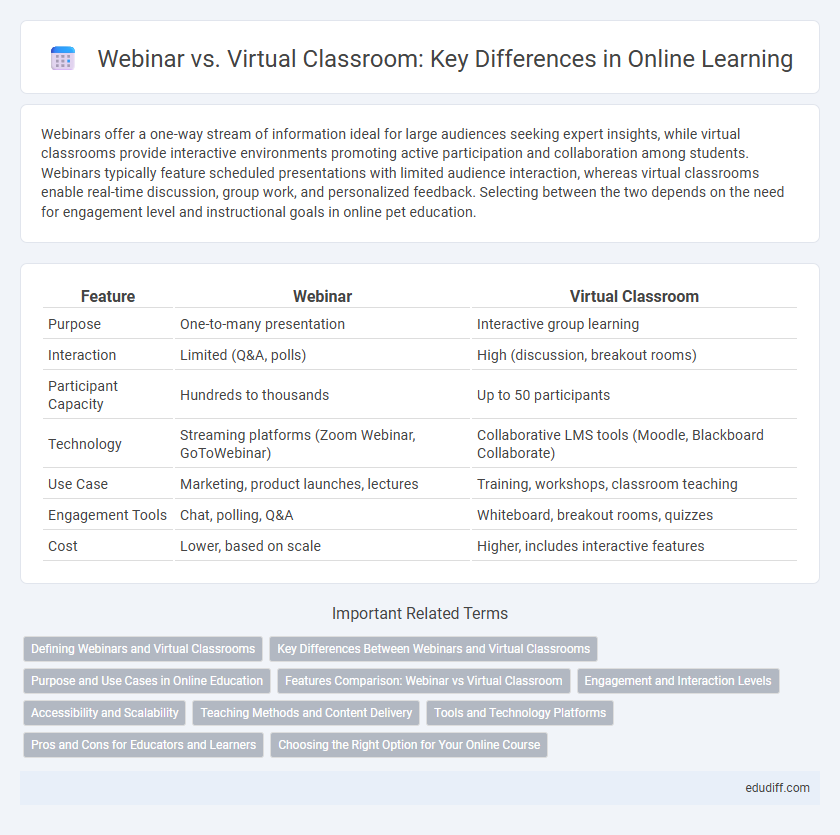Webinars offer a one-way stream of information ideal for large audiences seeking expert insights, while virtual classrooms provide interactive environments promoting active participation and collaboration among students. Webinars typically feature scheduled presentations with limited audience interaction, whereas virtual classrooms enable real-time discussion, group work, and personalized feedback. Selecting between the two depends on the need for engagement level and instructional goals in online pet education.
Table of Comparison
| Feature | Webinar | Virtual Classroom |
|---|---|---|
| Purpose | One-to-many presentation | Interactive group learning |
| Interaction | Limited (Q&A, polls) | High (discussion, breakout rooms) |
| Participant Capacity | Hundreds to thousands | Up to 50 participants |
| Technology | Streaming platforms (Zoom Webinar, GoToWebinar) | Collaborative LMS tools (Moodle, Blackboard Collaborate) |
| Use Case | Marketing, product launches, lectures | Training, workshops, classroom teaching |
| Engagement Tools | Chat, polling, Q&A | Whiteboard, breakout rooms, quizzes |
| Cost | Lower, based on scale | Higher, includes interactive features |
Defining Webinars and Virtual Classrooms
Webinars are live, instructor-led online sessions designed for broadcasting presentations to large audiences, often featuring one-way communication with limited interaction. Virtual classrooms provide interactive, real-time learning environments that simulate traditional classrooms, enabling two-way communication, collaboration, and engagement among instructors and students. Both platforms utilize digital tools, but virtual classrooms emphasize active participation and structured lessons.
Key Differences Between Webinars and Virtual Classrooms
Webinars typically involve one-way communication where a presenter delivers content to a large audience, making them ideal for lectures or marketing presentations. Virtual classrooms support interactive learning with features like breakout rooms, real-time discussions, and collaborative tools, enabling active participation and engagement. The key difference lies in the level of interactivity and participant involvement, with virtual classrooms designed for more dynamic and personalized educational experiences.
Purpose and Use Cases in Online Education
Webinars primarily facilitate one-way communication ideal for large audiences, focusing on presentations, lectures, and expert panels to deliver targeted knowledge efficiently. Virtual classrooms emphasize interactive and collaborative learning environments, supporting real-time discussions, group activities, and personalized feedback for smaller, engaged student groups. Educational institutions adopt webinars for broad information dissemination and virtual classrooms for comprehensive, immersive learning experiences.
Features Comparison: Webinar vs Virtual Classroom
Webinars offer one-way communication with limited interactivity, ideal for large audiences and presentations, while virtual classrooms provide real-time interaction, breakout rooms, and collaborative tools designed for small to medium-sized learner groups. Features such as live polling, Q&A sessions, and screen sharing are common in webinars, whereas virtual classrooms integrate whiteboards, group activities, and assessment capabilities to enhance engagement. Choosing between a webinar and a virtual classroom depends on the level of participant interaction and instructional control required for the online learning experience.
Engagement and Interaction Levels
Webinars typically offer one-way communication with limited participant interaction, often featuring Q&A or chat functions that engage attendees minimally. Virtual classrooms provide a more immersive experience with real-time discussions, breakout rooms, and collaborative tools that significantly boost engagement and foster active learning. Higher interaction levels in virtual classrooms lead to better knowledge retention and learner satisfaction compared to traditional webinar formats.
Accessibility and Scalability
Webinars offer high scalability by accommodating thousands of participants simultaneously, making them ideal for large audiences with minimal interaction. Virtual classrooms prioritize accessibility through interactive tools like breakout rooms and real-time collaboration, enhancing personalized learning experiences. Both formats leverage cloud-based platforms to ensure seamless access across diverse devices and geographic locations.
Teaching Methods and Content Delivery
Webinars typically use one-way presentations with limited interaction, focusing on content delivery through slides, videos, and live polls, which suits large audiences and concise information sharing. Virtual classrooms emphasize interactive teaching methods such as real-time discussions, breakout rooms, and collaborative activities, fostering deeper engagement and personalized learning experiences. Effective content delivery in virtual classrooms adapts to diverse learning styles, enabling instructors to tailor lessons with multimedia tools and immediate feedback.
Tools and Technology Platforms
Webinar platforms such as Zoom and GoToWebinar prioritize broadcast-style content delivery with features like live polls, Q&A, and attendee analytics essential for audience engagement. Virtual classroom tools like Google Classroom and Blackboard incorporate interactive elements including breakout rooms, collaborative whiteboards, and integrated assignment submissions to simulate in-person learning environments. Both tools leverage real-time video conferencing technology but differ in interactivity levels, where webinars suit large audiences and virtual classrooms focus on immersive, collaborative education.
Pros and Cons for Educators and Learners
Webinars offer educators a streamlined platform for delivering one-way presentations to large audiences, providing ease of setup and broad accessibility, but they limit interactive engagement and personalized feedback for learners. Virtual classrooms enhance real-time communication, collaboration, and active participation through tools like breakout rooms and polls, benefiting learner engagement and comprehension, though they demand higher technical proficiency and bandwidth from both educators and students. Choosing between webinars and virtual classrooms depends on the desired balance of interactivity, scalability, and resource availability in online education.
Choosing the Right Option for Your Online Course
Selecting between a webinar and a virtual classroom depends on the level of interaction and engagement required for your online course. Webinars are ideal for broadcasting information to large audiences with limited interaction, offering features like live polls and Q&A sessions. Virtual classrooms foster a more collaborative learning environment with breakout rooms, real-time discussions, and hands-on activities, making them suitable for smaller groups focused on active participation and skill development.
Webinar vs Virtual classroom Infographic

 edudiff.com
edudiff.com